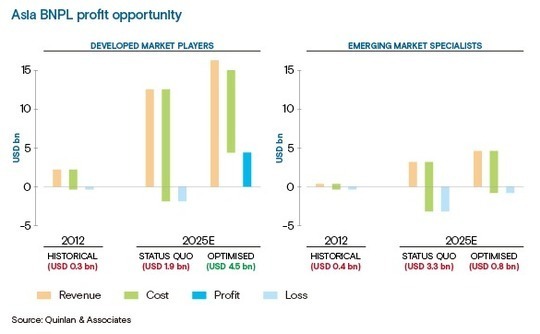
BNPL: Voodoo economics?

Credit-driven e-commerce is coming to developing Asia with an attractive supply-demand equation and a mix of macro and business-level risks. Start-ups are courting incumbents, not disrupting them
Buy now, pay later (BNPL) is a fundamentally different proposition in developing markets versus developed markets.
Where traditional credit availability is low, BNPL is not just a facilitator of instant gratification and a prop for e-commerce, it's a first foray for the unbanked into the world of credit. Investors interested in financial inclusion should take note, but so should those interested in product-market fit and workable models.
BNPL as a buzzword and business model is expanding rapidly in Asia, attracting increasing levels of venture capital investment, but not on track to be profitable in the region's developing markets.
In Asia's mature economies, the BNPL industry could swing from an overall loss of USD 300m in 2020 to a profit of USD 4.5bn by 2025 if companies make certain corrections to the model, according to Hong Kong's Quinlan & Associates. This includes mainland China.
In South and Southeast Asia, excluding Singapore, the industry will double its losses from USD 400m to USD 800m during the same period, even if models are optimised. If companies maintain the status quo, BNPL losses in the developing region will dive to USD 3.3bn.
Even the largest and most mature BNPL companies globally are still in the red. Revenues are surging but so are costs, especially in the form of loan delinquency. During 2021, US-based Affirm widened its loss from USD 108m to USD 379m, while Sweden's Klarna saw its loss quadruple to SEK 7.1bn (USD 755m).
Asia's standout player, Afterpay, which has a market capitalisation of about AUD 20bn (USD 15bn), is following the same trajectory and leading a BNPL rout on the Australian Securities Exchange. The stock tumbled 58% in the 12 months to a trading halt in January, when US-based giant Square was cleared for a USD 29bn acquisition.
The Square deal has done little to improve BNPL sentiment on the exchange. Afterpay's closest local competitors Zip and Latitude – which have market capitalisations around AUD 1bn and AUD 1.8bn, respectively – have seen their share prices fall 80% and 33% in the past year.
"The model with a lot of direct-to-consumer businesses is to generate profit as scale comes in, but I don't see that happening under the current models. It's not a problem of scale – it's a problem of unit economics. That's not going to be solved by having more customers," said Benjamin Quinlan, CEO and managing partner at Quinlan.
"Many VCs have gotten themselves into a space that I think is going to crash and burn. Once the VCs say, ‘show me the path to profit or I'll turn off the tap,' you're going to see a lot of these BNPLs go under."
Going large
The presumed strategy for investors in this space is to prioritise scale over profitability so as to be well-positioned for an accelerating consolidation process. Longer term, profitability can come as the BNPL company evolves into – or is absorbed by – a more diversified financial institution, perhaps after exit.
Singapore's Pace Enterprise appears to be among the more straightforward examples of this narrative, having achieved the distinction of being one of the few Asian BNPL operators with a multi-country footprint within a year of launch. The company raised USD 40m in Series A funding in November featuring VC units of Temasek Holdings and United Overseas Bank to grow its user base 25x within 12 months.
Taiwan's AppWorks joined the round. It noted that founder Turochas Fuad – whose experience spans leadership roles at WeWork, Spacemob, HomeAway, and Skype – had the necessary contacts to be competitive during a networking land grab.
"BNPL is in a consolidation stage right now and all the incumbents are doing M&A, so you need the right founder-market fit," said Sophie Chiu, an associate who led the investment for AppWorks.
"You need a founder with a background and ability to make connections in the industry – not just in terms of acquiring merchants but also getting partnerships with counterparties like banks and payment companies. Making BNPL work as an investment is about having the network and the creativity to expand the business beyond the simple instalment."

Furthermore, incumbent e-commerce platforms and financial institutions already have significant network and user base advantages. If there is no technical hurdle stopping them from setting up their own in-house BNPL systems, it could leave independent start-ups with overwhelming competition and nowhere to go in terms of M&A.
Key consolidators?
High profile examples of this scenario beginning to play out in Asian e-commerce include the recent launches of Shopee's SPayLater and Grab's PayLater services. In traditional banking, HSBC has enlisted US financial technology supplier Episode Six to develop BNPL capacities in its PayMe app.
Episode Six says its technology allows banks to reclaim revenue being lost to independent BNPL, although it also targets BNPL start-ups as clients. The company – active in the region across Southeast Asia, Japan, and Australia – claims a technical advantage in the ability to adapt to shifts in regulations, payment methodologies, and the types of assets recognised as currency such as crypto.
"Technology can absolutely be a key differentiator depending on how it's applied. Interoperability between payment schemes and providing for convergence between digital wallet offerings and BNPL could be quite interesting, for example," said CEO John Mitchell. "I think any bank can compete with start-ups if they focus and have the technology."
Incumbents in e-commerce, payments, and banking will be increasingly incentivised to establish in-house BNPL capacities as the market expands in the near term. In Asia alone, BNPL gross merchandise value is set to jump 39% to USD 361bn between 2022 and 2025, according to data from ResearchAndMarkets and Quinlan.
Joshua Chong, a BNPL analyst at Singapore-based fintech research firm Kapronasia, sees the consolidation theme as potentially inhibiting to VC investment in independents. He advises exploration of alternate entries into the market such as white label suppliers of technical infrastructure and B2B BNPL for small businesses that need more flexibility in inventory payments.
"I was under the impression some of the large BNPL companies could leverage the data they have to branch out into different services like larger loans, which could be a road to profitability. But I think that's a weaker argument now that they're more likely to merge with a larger platform," Chong said.
"We've also observed that products tend to be going down to smaller value items, which is unexpected. With Shopee SPayLater, for example, you could purchase a USD 10 pair of shoes over three instalments."
Under the hood
Ultimately, investor headaches in BNPL have more to do with business-level unit economics than industrywide trends around adoption, demographics targeting, and technology.
The crux of the issue is that BNPL companies typically charge merchant discount rates (MDRs) rather than interest. These would most likely have to be increased if the macro environment exacerbates costs, as expected, further incentivising merchants to develop in-house capacities.
In developing markets, MDRs can be as low as 2%, while delinquency rates can be as high as 7%. Reduced repayment volumes as a result of this spread mean there is less capital available for future credit extension. The shortfall is covered by generating more revenue by processing more transactions, setting up an escalation of the pattern.
The push for top-line growth itself entails significant costs around merchant and customer acquisition in the form of cashback discounts, credit card offers, paid marketing, and brand ambassadors among other gambits. Industry participants contacted by AVCJ estimated average customer acquisition costs (CAC) in the BNPL space in the region were in a range of USD 30-50.
Rocketship, a US-based investor with a significant portfolio in developing Asia, is strongly focused on embedded finance as a theme and impressed by the region's BNPL upside, suggesting the market could grow 10x in the next 4-5 years. But that's not enough.
"Sometimes, if you're very sticky and have a very high frequency of transaction, and there is scale associated with that high repeatability, then there is a path to profitability. That's the bet that everybody has to finally take," said Madhu Iyer, a partner at Rocketship.
"We have seen a lot of these companies and evaluated them. We don't have any investments yet, which should tell you something, but we continue to stay focused and bullish. It's always been a great category, but we have had a lot of pauses when we've come to looking at the numbers."
India's Simpl aims to crack the numbers issue with a BNPL invoicing product that digitally mimics local retailers' traditional practice of keeping informal "khata" tabs for their customers. These e-commerce accounts cannot exceed about USD 500 in a 15-day period even for the most creditworthy users, nor can they be extended until they are paid off.
Simpl, while not yet profitable, claims positive unit economics, with MDRs around 2.4% against net transaction losses of 1.3% translating into 22% margins. The company raised a USD 40m Series B in December led by US-based Valar Ventures and IA Ventures.
"It's more like Visa than a pay-later company," said CEO Nitya Sharma. "As we scale our business and volume, that 22% will eventually start paying for our cost structure, which is not much. If you're building a network, you'll have network margins, but if you're building consumer finance company, you'll get consumer finance margins. And you can do both at the same time."
Diversification drive
Most of the fixes for achieving profitability boil down to recognising BNPL as a feature rather than a standalone business. Diversification into other credit products such as payday loans, instalment loans and cash advances will be a natural path forward for the most robust independents. Smaller start-ups will be limited by the associated licensing and compliance hurdles.
The most cited winners in this game in developing Asia include Indonesia's Akulaku and Kredivo. Akulaku has raised around USD 450m in VC funding, claiming a USD 2b valuation last month after an investment from Siam Commercial Bank. Kredivo, also known as Finaccel, raised more than USD 460m before agreeing last year to merge with a US-listed special purpose acquisition company (SPAC) at an enterprise valuation of USD 2bn.
India's BNPL leader is arguably Capital Float, which has raised USD 474m in equity and debt from the likes of Sequoia Capital India and Amazon. CEO Sashank Rishyasringa claims the company – which is also active in personal loans and personal finance management services – is already contribution margin positive and on a path to profitability "in the next couple of years."
The key to Capital Float's approach is in its alignment with the financial inclusion ideals of bringing BNPL to the developing world as a tool of upward mobility. The company looks at its market engagement through a lens of affordability rather than convenience.
Basically, BNPL is used as an entry point for reaching out to a population of 100m e-commerce newcomers with no access to credit. The idea is to help them start small with credit lines suitable for groceries and everyday lifestyle products. Bigger-ticket categories such as travel and education can be accommodated over time, eventually leading to the offering of non-BNPL products.
CAC is said to be zero thanks to what Capital Float calls India's first and still largest point-of-purchase instant credit program. The company has a network of 3,000 merchants, including Amazon, and some 4m BNPL customers. About 200,000 new customers are added every month purely through at-checkout underwriting.
Rishyasringa said his company – which has a license to lend with the central bank and bears its credit risk – has a loss rate is 1.2% and a gross non-performing asset rate that is "the lowest in the industry by far" at 0.8%. He sees a future for BNPL in further integrations with traditional banks, which are still lagging in their development of capacities around alternative credit scoring and small-ticket debt collection.
"You're going to see banks are able to build retail loan portfolios with zero costs, but players like us – experts at underwriting and collections and acquisitions – will handle the entire lifecycle of the customer," Rishyasringa said. "Banks provide the capital and we provide 20% skin in the game. That's probably going to be the dominant model going forward."
Credit risks
There are important cultural and behavioural factors in the BNPL-for-developing-Asia paradigm that are yet to play out.
As the region's first online generations experiment with credit, anecdotal observations are mounting around the emergence of increasingly risk-happy attitudes about spending versus saving and susceptibility to influencer-driven discretionary shopping via constructs such as social commerce. BNPL could prove a toxic ingredient in this soup.
The risk persists even if the phenomenon stays rooted in small-ticket purchases – which would theoretically limit the damage of defaults – because such a BNPL industry would remain under the radar of regulators. To date, the Philippines in the only market in developing Asia with significant BNPL regulatory supervision.
Currently, most providers do not maintain and share proper records on the indebtedness of their end-users, who can turn to other unwitting credit channels and become overleveraged. From the company perspective, this could backfire by reducing the end-customer's ability to pay down the original BNPL debt. For the broader industry and society at large, the stakes are much higher.
"You will see a growing middle class in developing Asia, rising into the next segment of being able to purchase more moderately priced and luxury goods. There's nothing wrong with that. But what's the mechanism to get there? BNPL is consumption on steroids," said Quinlan.
"Eventually, when the economy starts to recede – which everyone is thinking will happen at some stage and we're just wondering when – then how does this all unravel?"
Latest News
Asian GPs slow implementation of ESG policies - survey
Asia-based private equity firms are assigning more dedicated resources to environment, social, and governance (ESG) programmes, but policy changes have slowed in the past 12 months, in part due to concerns raised internally and by LPs, according to a...
Singapore fintech start-up LXA gets $10m seed round
New Enterprise Associates (NEA) has led a USD 10m seed round for Singapore’s LXA, a financial technology start-up launched by a former Asia senior executive at The Blackstone Group.
India's InCred announces $60m round, claims unicorn status
Indian non-bank lender InCred Financial Services said it has received INR 5bn (USD 60m) at a valuation of at least USD 1bn from unnamed investors including “a global private equity fund.”
Insight leads $50m round for Australia's Roller
Insight Partners has led a USD 50m round for Australia’s Roller, a venue management software provider specializing in family fun parks.







